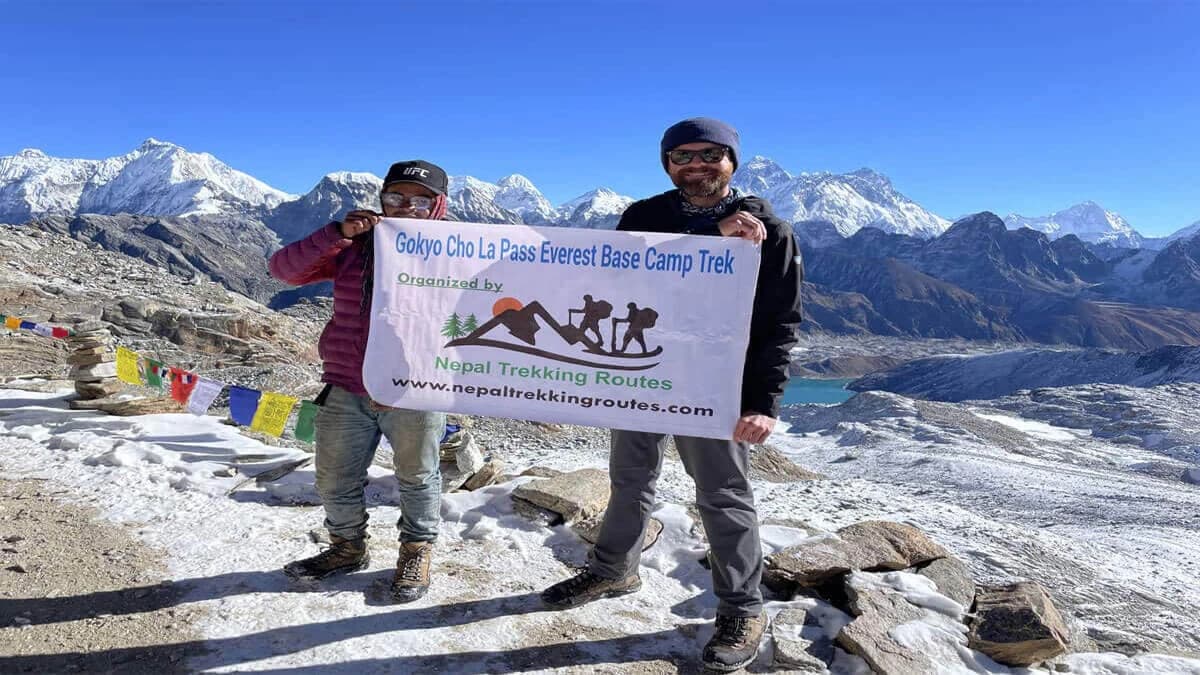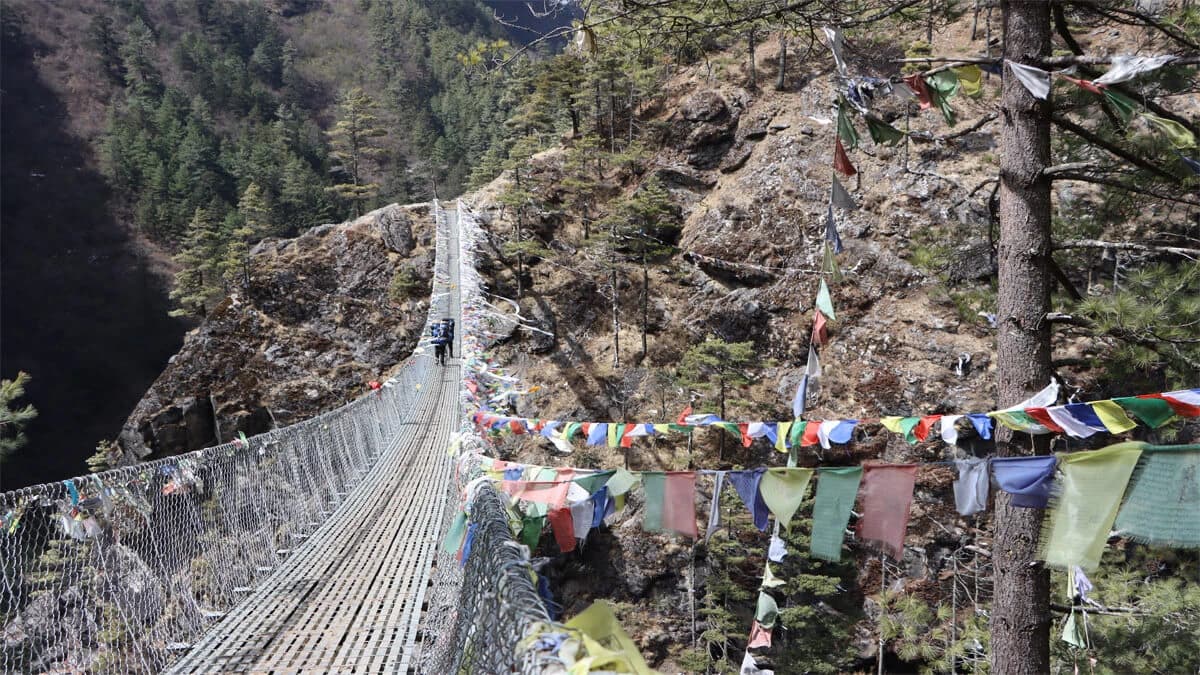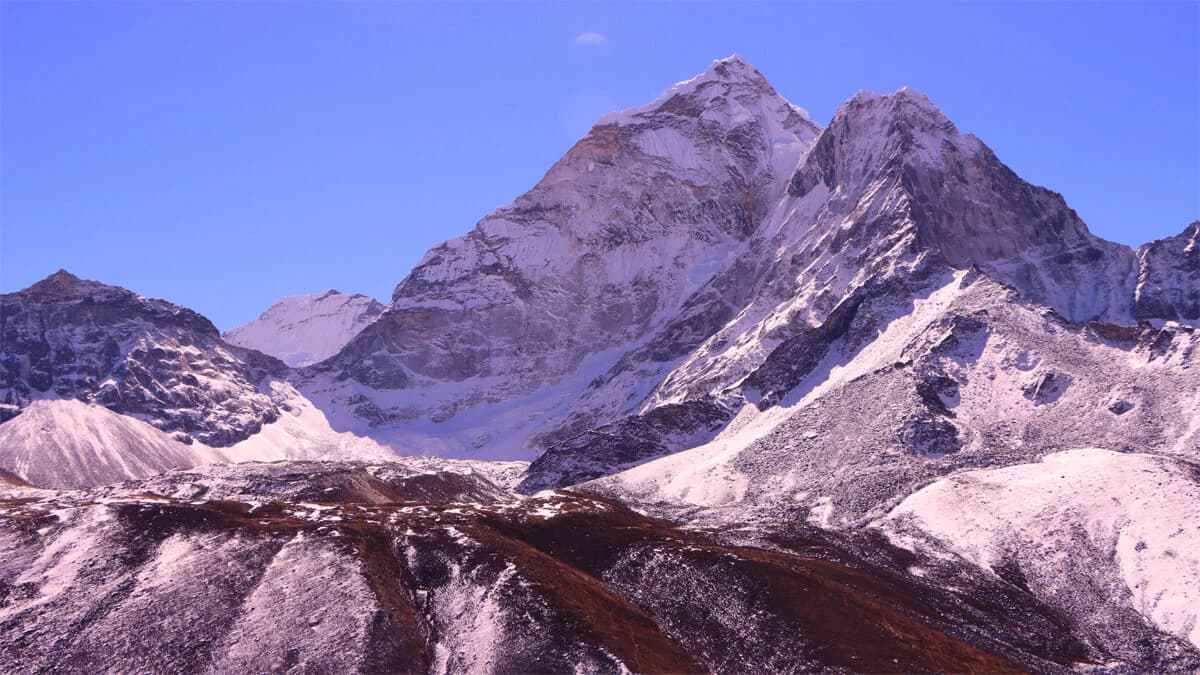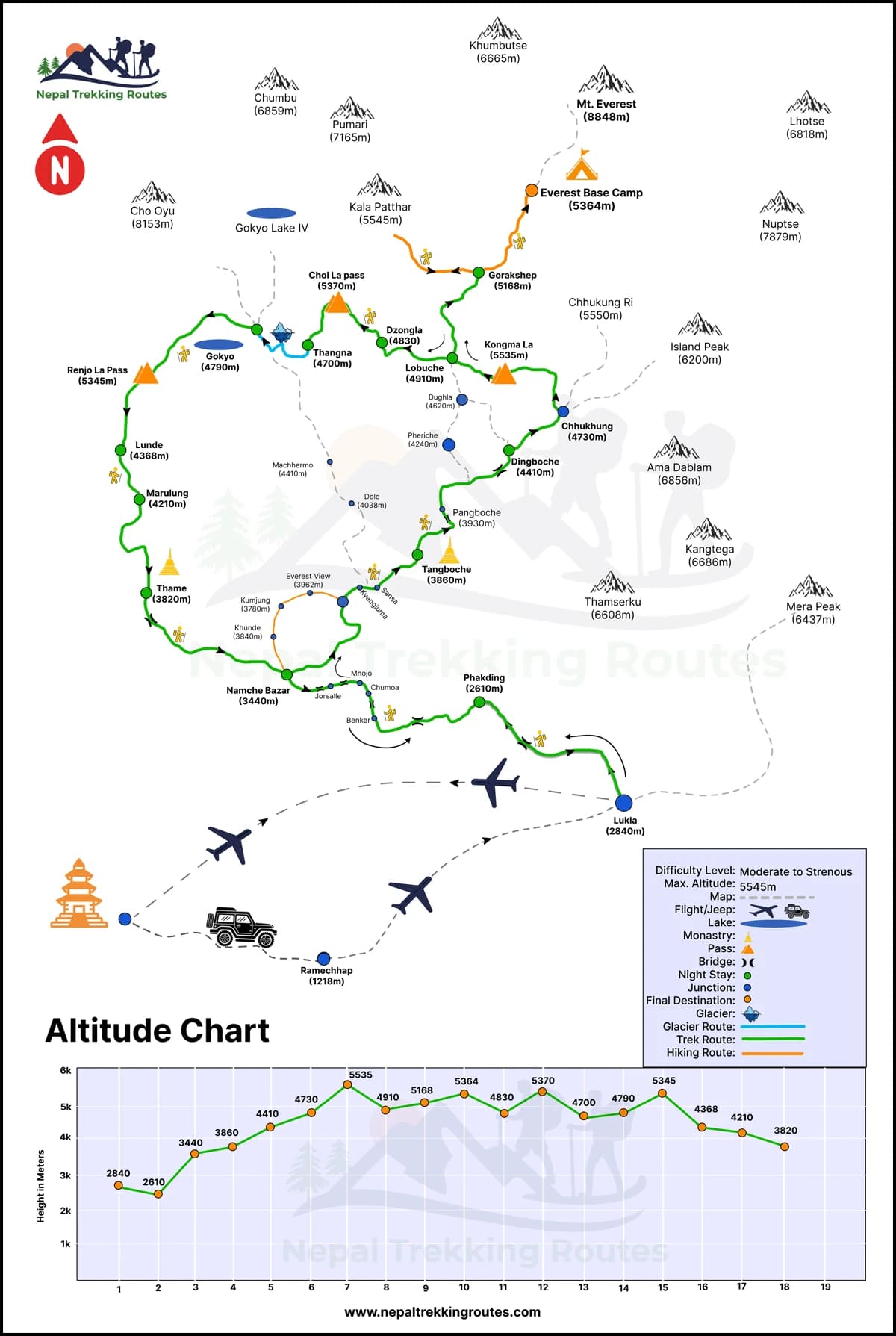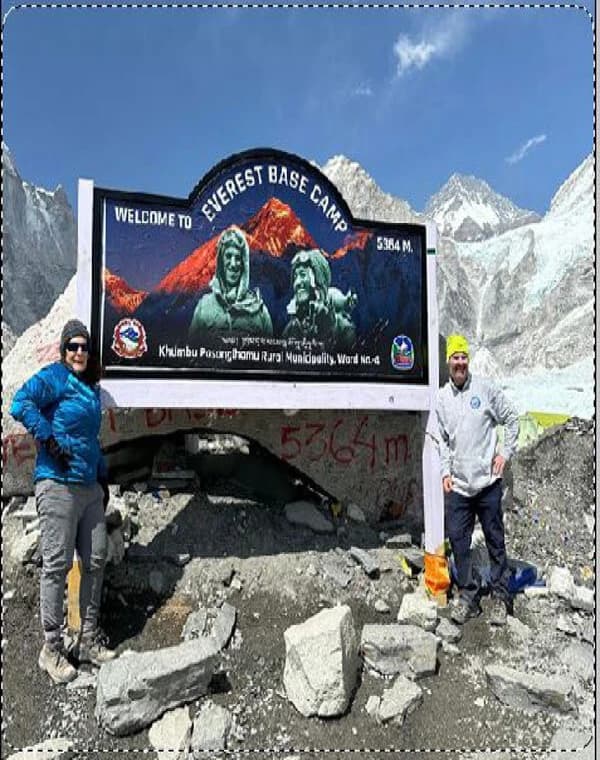Everest Three High Passes Trek is the most appropriate trek for adventure lovers. It becomes more challenging by adding three high passes to Everest Base Camp Trek. The three high passes are all above 5,000 m. Climbing gears are required to cross these passes to avoid any possible accidents. This trek takes you along the dense forests of Sagarmatha National Park. It is one of the highest altitude conservation areas in the world. So, it is recorded in the UNESCO World Heritage Sites. It has conserved various animal, bird, and plant species of the Himalayan region.
19 Day Everest Three High Passes Trek Cost for 2025 and 2026
Everest Three High Passes cost range from $1700 to $2100 per person including permits, transportation, guide, accommodation and meals. Nepal Trekking Routes offers the cost for the 19 Day Everest Three High Passes Trek for 2025 and 2026 depending on group size, individual preference and level of services. You can choose basic, standard and Luxury options that suits you budget. You can contact our advisor via email or Whatsapp for group discounts and budgeting options.
What to expect on Everest Three high passes trek?
If you trek around the Everest region in spring, the entire oak, pine, and fir forests are embellished by colorful rhododendron flowers. On the way, you might encounter some animals like musk deer, snow-leopard, Himalayan that, and birds like Himalayan Pheasants. The snow-capped peaks of the Great Himalayas are equally rewarding. The Three High Passes trek Nepal rewards you with the beautiful mountains of the Everest region. Mt. Everest (8,848 m), Mt. Lhotse (8,516 m), Mt. Cho Oyu (8,188 m), and other peaks come into your sights.
The Sherpa Villages of this region are the best source for first-hand knowledge about their lifestyle, culture, and tradition. Besides, you see ancient monasteries, chortens and mane walls during this trek. The howling sound of the prayer flags over these shrines makes your mind and heart peaceful. Everest View Hotel (3,880 m) is a major attraction of this region. One of the highest altitude hotels in the world, you can have a picturesque view of Mt. Everest and other peaks. Moreover, the Sherpa Museum shows you the photos of Tenzing and Hillary from the 1953 Everest Expedition.
Important Buddhist Cultural Heritage and Festival
Tengboche Monastery and Pangboche Monastery are the most important Buddhist cultural heritage sites of this region. Tengboche Monastery is the largest Tibetan Buddhist shrine in the Solukhumbu region. Additionally, Pangboche Monastery is the oldest of this type in the Everest region. Mani Rimdu Festival is the most colorful festival of the Sherpa living here. This festival falls in between October and November. It is celebrated for 19 days at the premises of Tengboche Monastery.
The monks of the monastery perform the cultural dance by making a circle. They sing traditional Sherpa songs and beat the drums. The people of this region gather in the monastery premises and celebrate the festival in front of the Guru Rinpoche.
Everest Base Camp and Kalapatthar Sunrise View Point
From Lobuche, you trek to Everest base camp by enjoying the view of the Khumbu Glacier and the Khumbu Icefall. Gorakshep is the last human settlement area of the Everest region close to the base camp. You spend a night at a hotel here to hike to Kalapatthar the following morning.
Everest Base Camp (5,364 m) is the highest point one can reach near Mount Everest. From here, you can see the snow-covered mountains except Mt. Everest itself. Mt. Lhotse, Mt. Cho Oyu, Mt. Amadablam, and other peaks are seen from here. Kalapatthar is the best viewpoint of the Everest region that you must not miss. To have the sunrise view of the Great Himalayas, you should begin trekking in Nepal from Gorakshep after midnight. From here, you can shoot pictures and films by keeping Mt. Everest on the background.
Acute Mountain Sickness during Everest Three High Passes Trek
In fact, when you reach a place higher than 2,500 m, there is a possibility of Acute Mountain Sickness (AMS). Everest High Passes Trek takes you above 5,000 m passes. You have to spend most of the time in a place higher than 3,000 m. Not only while walking but also spending night in the Everest region trek, you may suffer from altitude sickness. Nevertheless, you can avoid AMS if you take a few precautions. First, you have to drink enough water to prevent dehydration. Then, you should have hygienic food items and sound sleep.
Walking slowly by taking enough rest during the Nepal trekking is also another precaution. You should avoid alcohol, cigarette smoking, and junk food while in high altitude. More importantly, you should not eat non-veg items as they may not be fresh. Next, you should always follow the instructions given by the Nepal trekking guide. In case you feel any of the symptoms like shortness of breath or extreme fatigue, you should tell it the guide.
How to Begin Everest Three High Passes Trek?
Everest Three High Passes Trek is a challenging trek in the Everest region. Everest Three High Passes Trek guide comprises Everest Base Camp trek crossing three high passes all above 5,000 m. Three High Passes trekking route is more difficult than walking along the traditional route to the base camp of Mount Everest (8,848 m). To start this trek, you have to fly from Kathmandu to Lukla (Tenzing Hillary Airport). Lukla is the gateway to start the Everest region trek. You follow the same traditional trail up to Dinboche. You go past Phakding, Namche Bazaar, and Tengboche along the Dudh Koshi River Valley.
From here, you divert towards Chhukung Valley which is a preparation center for Chhukung Ri climbing or Island Peak climbing. By crossing Kongma La (5,545 m), you descend to Louche. From Lobuche, you go to Gorakshep to reach Everest Base Camp (5,364 m) and Kalapatthar (5,550 m). After having the 360-degree panoramic view of Mt. Everest and other peaks, you climb down to Dzongla. Crossing Cho La (5,420 m), you reach the Gokyo Lake trek which is famous for six glacial lakes. On the rest day, you climb Gokyo Ri (5,357 m) to have the breathtaking view of four 8,000 m peaks.
Finally, you climb Renjo La (5,370 m), the last high pass, you climb down to Marlung. Then, by walking past Namche Bazaar, Phakding and Lukla, you fly back to Kathmandu.
Everest Three High Passes Trekking Highlight
- Kathmandu Lukla scenic flight
- Kongma La (5,545m), Cho La (5,420m) and Renjo La (5,370m) climbing
- Trekking Three high passes and Gokyo Lakes Valley
- Gokyo Ri (5,357m) to have an astounding view of Mt. Everest, Mt. Lhotse, Mt. Makalu, Mt. Cho Oyu and many more
- Ancient monasteries of the Everest region
- Everest View Hotel and Kala Patthar for breathtaking view of Mt. Everest and other peaks
- Renjo La Pass and Fifth Gokyo Lake as the other vantage points
- Flora and fauna of Sagarmatha National Park
Is it possible to Customize Everest Three high Passes Trek Itinerary?
Nepal Trekking Routes offers Everest Three Passes 18-day trek itinerary. The Everest Three High Passes Trek can be tailored to suit your pace and preference:
- Changing the Starting Point: Jiri or Lukla are good places to start. Lukla provides a faster path, whereas Jiri adds additional trekking days and cultural exploration.
- Route Order: The three passes- Kongma La, Cho La, and Renjo La, can be done clockwise or counterclockwise. It depends on acclimatization and your preferred level of difficulty.
- Add Side Trips: Include side trips like Ama Dablam Base Camp, Chhukung Ri, or the serene Gokyo Lakes.
- Flexible Timing: Adjust rest and acclimatization days for safety and enjoyment.
Comparison of Everest Three High Passes vs Everest Base Camp
Everest Three High Passes and Everest Base Camp, both routes are unforgettable. The Everest Three High Passes includes crossing Kongma La, Cho La, and Renjo La passes. It offers breathtaking views and fewer crowds. This trek is suitable for experienced trekkers looking for challenge.
On the contrary, Everest Base Camp is a traditional route that leads to the base of Everest. It includes Sherpa culture, charming villages and famous viewpoints like Kalapatthar. It is less demanding than the Three Passes trek but equally rewarding.
Food and Accommodation Facilities During Everest High Passes Trek
Everest region trekking is the most popular trek in Nepal. Therefore, numerous hotels, lodges, and tea houses are established en route. All the stopovers on the route have hotels or tea houses to provide good food and accommodation facilities. However, the higher you go, the more basic food and accommodation facilities are found. In the peak seasons, you may have difficulty finding a tea house on arrival. So, you have to reserve them earlier before starting the trek or at least, reaching the destination.
You should be ready to sacrifice the luxury trekking in Nepal at a high altitude. Because of the lack of transportation facilities, you don’t find the foodstuffs of your choice here. The tea houses don’t have hot water for bathing as well. If you need hot water, you have to pay extra charges.

